| The
Beginner's Microscope?
A look at an old example with some personal thoughts. By Paul James ( UK )
|
| The
Beginner's Microscope?
A look at an old example with some personal thoughts. By Paul James ( UK )
|
My very first peep through a microscope at the age of 10 left me in no doubt that this was a fascinating hobby. The microscope was owned by a very interesting gentleman who indirectly did much to enthral my senses and make me aware of many things both big and small. I owe him much gratitude for my life long interests in microscopy, astronomy and photography which have remained with me to this day.My father gave me a 'toy' microscope some time later, and though it was a very simple and rather crude instrument by professional standards, it served me well at the time. I suppose the important consideration for me at the age of 12 was that it was 'MY' microscope!
I don't really think a young person who looks through a proper microscope can appreciate its virtues, and so the 'toy' microscope may well serve as it did for me, a useful service. Being by its very nature a simpler design will allow the youngster to get on with the 'peeping' without recourse to complex adjustments. This initial inquisitive experience is very important and anything that hinders it might well dampen future interest, so I am of a mind that believes that the 'toy' microscope can sow the seed of a life long interest in microscopy. Others will have different tales to tell.
The Greenkat microscope
This microscope was produced a few years back, and was a good example of its kind.
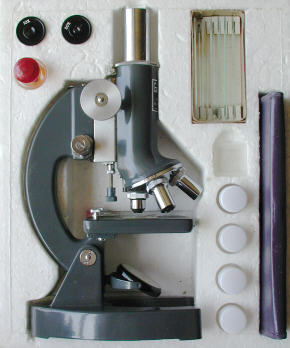 |
|
|
Design and Build QualityThis microscope certainly looks like its larger cousins, and though made for the youngster, it has some mechanical features that are rather impressive. The coarse focussing is made in traditional style which looks and feels smooth and positive, and surprisingly there is a fine focus too, though I cannot really see the point of this as the title on the box is in fact misleading " x 80- x 1200 " ?? The actual magnification range is more like x 25 - x 300. This obsession with high power is common to most 'toy' microscopes.
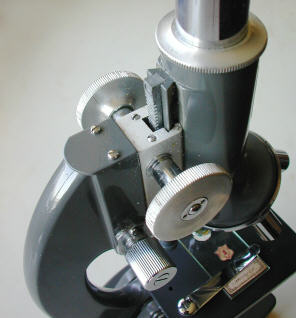 |
The stage is plain and simple and has basic clips, below which the double sided mirror is also perfectly adequate. There is a rotatable disc immediately below the stage which contains a number of diminishing apertures. This can be adjusted for alignment. There is also a single element condenser lens fixed into the stage's aperture.
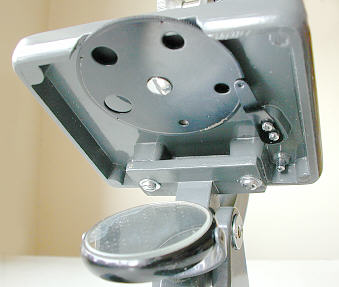 |
Optical PerformancePlacing in my opinion too much emphasis on providing 'high' a power objectives whose quality is rather questionable, makes demands on the skills of the young observer which are understandably lacking. It appears that all the lenses used in the objectives are bi-convex forms, used in pairs to reduce chromatic aberrations. There is as might be expected, much chromatic fringing on images and a general lack of detail compared with standard microscope optics. However, the two lower power objectives are in keeping with the expected standard of this microscope. Much of the high power magnification is 'empty', but general shape and detail is evident as can be seen in the images below taken with a Nikon Coolpix 800 digicam:-
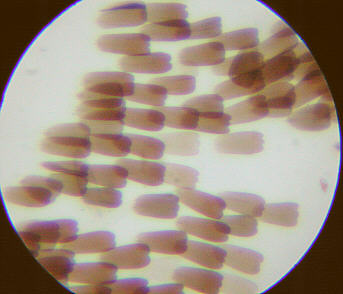 |
| Butterfly scales at low power |
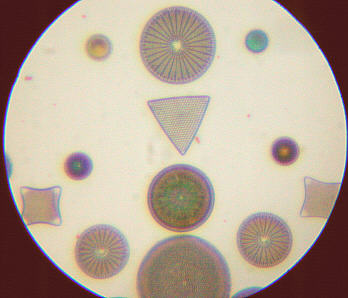 |
| Diatoms at medium power (x 80?) |
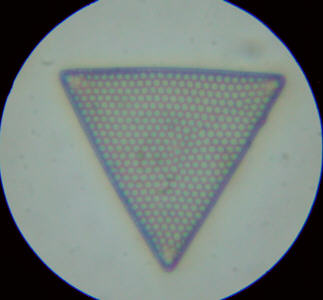 |
|
image has caused white balance problems. |
SummaryWhilst there are a few shortcomings in this microscope, there are some well made and well thought out features.
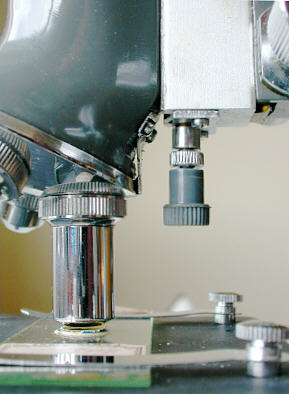 |
The adjustable focus stop seen above is a very sensible device for the beginner. Arresting the downward travel of the coarse focus in this way is a very positive and practical method of avoiding slide damage, and rarely found on full size stands.My main criticism is that the makers, who have produced a creditable stand with fairly decent mechanical attributes, could have concentrated solely on manufacturing just a couple of higher quality low power objectives, and not provided high powers. I think this would have been more appropriate for a youngster.
Perhaps, as I have already stated, the important point in a beginner having a toy microscope is that it is 'theirs'? And when the day arrives to upgrade to a more conventional stand, they will be more appreciative of the inherent quality of their new 'scope. My 'toy' 'scope cost about £5 in 1956, which in today's terms is a good half a week's wages. How times have changed!
The bottom line however, is that today the relative costs of making technological items has fallen dramatically for a variety reasons, and for a little more money, a durable and more creditable full size stand can now be bought.
Comments to the author Paul James are welcomed.
Please report any Web problems or offer general comments to the Micscape Editor.
Micscape is the on-line monthly magazine of the Microscopy UK web site at Microscopy-UK